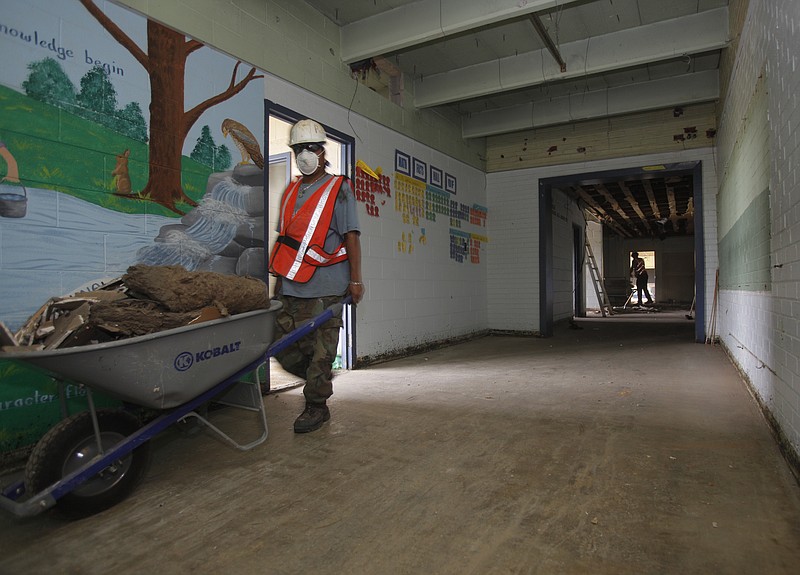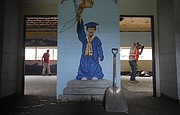Five years after the 2011 tornado outbreak, people are still healing from the terror and heartache of that day. But some scars are more apparent than others.
The tornadoes, some a mile wide, barreled through the lives of thousands in their paths and left wastelands behind. Trees older than anyone alive were ripped from the ground and launched like missiles into buildings. Brick homes were wiped clean off the face of the Earth, leaving behind only bare, concrete slabs.
Matt Ryerson, president and CEO of the United Way of Bradley County, said his home was in the direct path of one of the worst tornadoes of the day - an EF4 that ripped through Catoosa County, Ga., before crossing into Southeast Tennessee.
"My wife and I actually saw it coming," he said. "It was well after sunset, but you could still see the light on the horizon and we could see a perfect funnel cloud coming at us."
Ryerson and his wife grabbed the kids and dove into a closet moments before the chaos began. He said it sounded like a deafening chainsaw.
"Literally, our ears were popping from the pressurization of the house. It felt like it lasted 10 minutes but it probably lasted 10 seconds," he said.
When he and his family finally emerged from the closet, they were sure the house had been destroyed, but miraculously it was largely intact. The same couldn't be said for eight other homes on the block.
For hours, and then days afterward, the Ryersons' front yard became a thoroughfare for responders who used it to bypass a group of trees that had snapped, blocking the road to the many victims beyond. Dispatchers knew where help was needed, but emergency crews had to inch forward through mazes of fallen trees that made rescue painstakingly slow.
Bradley County Mayor Gary Davis said he was in the 911 center listening to thousands of calls coming in from panicked citizens, some of whom just wanted to know someone was coming.
"I remember being at the 911 center thinking, 'When is it going to stop?' Usually you just have one wave, but this time they kept coming and they kept getting worse," he said.
The destruction Ryerson's neighborhood experienced was mirrored throughout the county, he said. Entire lives were in rubble.
"There are a couple of paths all the way across Bradley County coming out of Hamilton County at a northeast angle all the way across the southern, southeast part of the county that, from a plane, are still evident," he said. "Millions of trees in that path were just laid down and the houses, too."
In all, nine people died in Bradley County that day.
Gary Farlow, president and CEO of the Bradley-Cleveland Chamber of Commerce and a volunteer who helped organize the recovery effort, said the community still bears those losses, especially at this time of year as the anniversary approaches.
"If you have a death in the family, it's something you never forget. It was a sudden thing, and there were some pretty difficult times for several people," he said. "It's not one of those things you ever really get over.
"Some of those people who were directly impacted probably get nervous whenever they hear a thunderstorm."
But in the face of overwhelming pain and terror, the community tried to move forward, working to outdo the destructive force of the tornadoes with its own massive repair effort in the aftermath. Public leaders, emergency responders and volunteers started organizing - compiling lists of needs and resources and breaking out the chainsaws to recover what they could of their former worlds.
With support from the Federal Emergency Management Agency the immediate needs of those directly affected were addressed, but the community also set up a long-term recovery organization to deal with problems that would take much longer to fix. Ryerson, a volunteer in that group, said it was a privilege to see the community build what he called a "new normal."
About 20 miles away in Hamilton County, another citizen began doing her part to help a small town that lost nine people to one of the same tornadoes that tore through Bradley County. Mariah Prescott was working at CN Utility Counseling in Apison when the tornadoes hit, and as the storms cleared she started asking herself what she could do to help.
With direction from a co-worker who helped organize a project in Georgia called Replanting Ringgold, she started a similar program called Replanting Apison and spearheaded the effort to jump-start the recovery process.
Prescott raised money from sponsors and brought in hundreds of 5-foot-tall trees for the residents who were hit hardest. Then a group of volunteers offered what time they could to begin restoring the landscape.
"Apison used to be just this beautiful, hardwood forest covered in trees like the rest of the Chattanooga area, and after the tornado it just wiped everything clean out," she said. "People would tell me that they would be driving home and almost get lost because they were used to seeing this giant red oak tree in the corner of their driveway and that's where they knew to turn."
Prescott said most of the trees from Replanting Apison have survived, and progress has been made on the bald tracts of land the tornadoes left behind. Some businesses and homes also have been rebuilt to replace what was lost five years ago.
Ryerson, though, said he can still see the lasting scars of the tornadoes in the faces of his children who were with him in that closet.
"Every time they hear a roll of thunder, you can see the anxiety. Once you've lived through that and you've seen how powerful those storms can be, it can rock your confidence a bit."
And no matter how many homes are rebuilt or trees are planted, there is only so much that can be repaired.
"We lost people that were close to us," Ryerson said. "You can fix people's houses, you can give them a better house, but their daughter's gone or their brother's gone or their sister-in-law is gone. You can't fix that."
Contact staff writer Emmett Gienapp at egienapp@timesfreepress.com or 423-757-6731.

